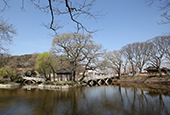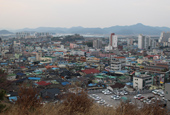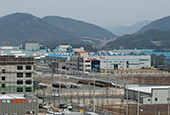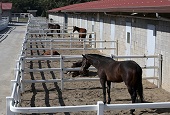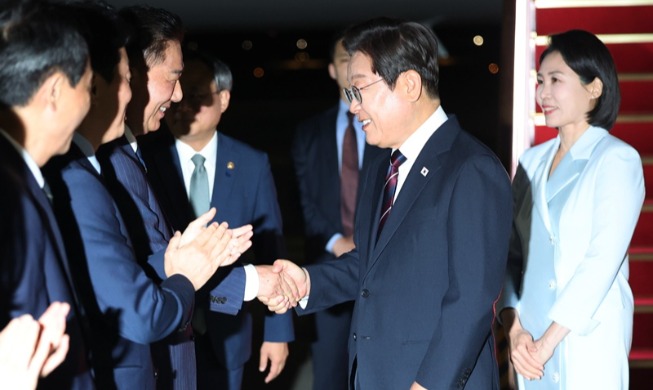"We will transform Haman into a place with 100,000 people and make sure it is upgraded to a proper city."
"We have a floating population of about 150,000, including 33,000 workers who work at 14 industrial complex across Haman," said Haman-gun County Mayor Cha Jeong-sup. Cha said he would try to help them settle in the county, thereby helping it to become a high-class, self-sufficient city.
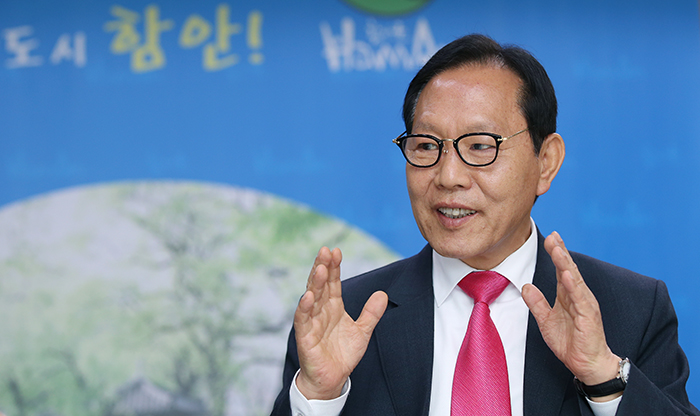
The size of Haman's floating population more than doubles its resident population of 70,000. Cha said that if the housing demand was met, allowing the workers to live in the county, the county's total population would exceed 100,000 in just a few years. Haman is now building a small residential area to house its planned cultural and welfare facilities. It will build 10,000 new apartment units and build educational and community centers in the new development so that employees who work at the industrial complexes can live in Haman.
Haman signed a memorandum of understanding (MOU) with Buyoung, a midsized construction company, in December 2014 to build 2,000 rental-only apartment units by 2018.
"We will turn the farming city of Haman into a high-class, self-sufficient city that has everything that an industrial and enterprising city would have, that a leisure- and sports-focused city would have and that an environmentally friendly city would have," said Cha.
"There are currently 14 agricultural and industrial parks in operation, and there will soon be 15 more industrial complexes. Companies moving to the new industrial parks will be a huge driving force, leading the development of Haman."
County Mayor Cha was born in Haman and began his career as a public servant after graduating from high school. He then joined the Ministry of Culture and Information, and then, as a high-ranking official, he dealt with issues regarding youth protection and other welfare policies at the Ministry of Health and Welfare. In total, Cha has worked as a public servant for over 40 years. County Mayor Cha was asked about Haman's economy, tourism, history and about regional affairs.
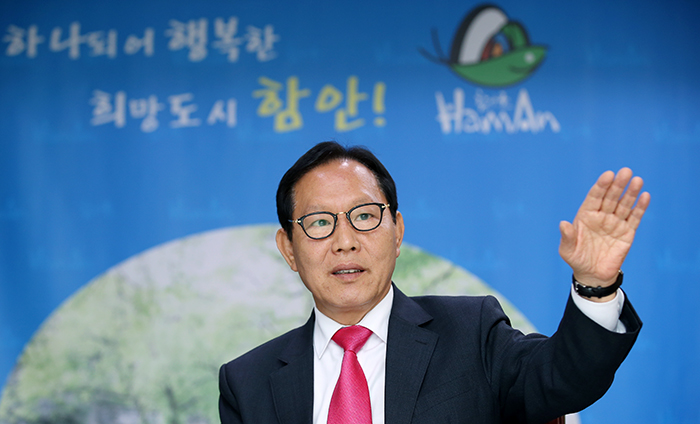
- The history of Haman-gun County dates back to before the Proto-Three Kingdoms of Korea, to around 200 B.C. Since long ago, iron and metalsmithing were well-developed and many ancient kingdoms prospered in the region. What is the reason behind such long prosperity?
Haman is located in the middle of Gyeongsangnam-do (South Gyeongsang Province). It is here that the Nakdonggang and Namgang rivers conjoin. Wide alluvial plains spread out across both river basins, a key condition for the birth of civilization. The first ancient kingdom in Haman was a state called Byeonjin Anya, part of Byeonhan and Jinhan, during the Proto-Three Kingdoms of Korea (roughly A.D. 0-A.D. 300). Aragaya, part of the Gaya Confederacy (42-532), existed for over 600 years and it was considered one of the most advanced polities within the Gaya Confederacy. Aragaya then grew into a leading power within the Gaya Confederacy as it had a very well-developed steel industry. That is why Aragaya is called the, "Kingdom of Steel." Its steel smelting, and the history of the rise and fall of Aragaya, can be seen in the complex of ancient tombs on the slopes of Malisan Mountain in Haman-gun County.
- Haman-gun County has the biggest population, and the largest number of young adults, among the counties of Gyeongsangnam-do (South Gyeongsang Province). It is also ranked first in terms of financial self-sufficiency. What are the reasons?
Most of all, over 3,000 companies in the region play a large role. Haman was traditionally a farming town, but now there are many companies and industrial parks here thanks to industrialization. The county has a well-developed greenhouse agricultural industry and a range of manufacturing industries, and has turned into an urban area now. Haman is adjacent to Changwon and Jinju, both of which are metropolitan cities with some 1.1 million people each. The county has a well-developed transportation network, such as railways, local roads and expressways, and it can easily be reached from anywhere in the country. The place is convenient for corporate logistics and transportation.
Due to these reasons, there are an increasing number of companies moving to the area. This has led to an even faster growth in population than in other counties across the province. Haman's self-sufficiency in terms of its finances is also the greatest among the counties in Gyeonsangnam-do. The county's gross regional domestic product (GRDP) per capita was the second highest for six years in a row across Gyeongsangnam-do. Haman is the best place to live in Gyeongsangnam-do and has strong potential for future development. Come to Haman. It's a good place to live.
- Unlike other regional governments, Haman has a balance between agriculture and industry. How attractive are conditions at the industrial parks? What are the advantages that attract foreign direct investment (FDI) and which help to expand the county's relationships with international corporations?
Haman has a very well-developed transportation network, such as the KTX high-speed train, the Namhae Expressway, the Jungbu Inland Expressway and a crisscrossing of local roads. It is in proximity with large logistics centers, such as Busan, Masan and the Gwangyang ports, and with both Gimhae International Airport and Sacheon Airport. Thus, it has an optimal infrastructure for business.
In addition, there are eight universities here, including Changwon National University and Gyeongsang National University, six two-year colleges and 13 technical high schools. The fact that we can provide a stable source of human resources to meet companies' needs is also a great advantage. We intend to build a database of companies we intend to attract to the region through the Korea Trade-Investment Promotion Agency. We also plan to send our promotional team overseas to explain the great conditions that exist at our industrial parks for foreign companies that are interested in investing in Korea. In addition, we plan to draw up detailed investment plans, such as designating a "foreign-invested zone," providing subsidies and helping to build basic infrastructure. As for incentives for FDI companies, there are both national and regional tax breaks, as well as discounts on rent, and no-interest loans.
- There is a huge equestrian and horse-related industry, including breeding programs and training centers for racehorses, as well as a network of horseback riding courses. Please tell us more about this.
Horses are very sensitive animals. Once they participate in a race, they need to rest for at least one month. Racehorses at a Busan track can rest on Jeju Island. Horses are transported from the track to Busan Port, and from there by boat to Jeju. They are moved from Jeju Port to an inland ranch. It takes a whole day. This is a huge stress on the horses.
So Haman decided to build a ranch and training facility for racehorses in the county. Haman is only a 40-minute drive from Busan. The high quality rest facility at the ranch has already been proven. The facility is exempt from quarantine inspection, a first in the province. Horseback riding is one of the best leisure activities for the 21st century. No matter if you're young or old, man or women, it is one of the most optimal sports for one's health and rehabilitation.
If yachting is one of the best marine sports, horseback riding is one of the best sports done on land. There are many tourist and leisure activities, too, including breeding horses, training horses, training retired racehorse to become leisure horses, and operating horseback riding training courses. There is also the manufacturing and distribution of equestrian goods. We intend to develop all of these as one industry covering agriculture, manufacturing and the service sector, and we expect to create jobs and give a boost to the regional economy.
- Haman has a well-established infrastructure and provides some of the highest childbirth incentives and child rearing rebates, as well as daycare services. It also helps low-income households and seniors become economically independent. The county must need a large amount of financial resources to pay for all of this.
The county allotted KRW 87.6 billion to social welfare this year, which reflects a KRW 12 billion increase over last year's figures. This makes up 30 percent of the county's total budget, and the welfare budget accounts for a larger portion of that. However, in order to provide sufficient welfare services to make our residents truly feel at home here, it is important to secure the necessary financial resources.
The central government does not simply give us money whenever we need it. We can only receive assistance for specific projects that are in line with the central government's current policies. From my long experience in the central government, I know how to approach the issue when we try to secure money for a project.
For example, we recently tried to establish a "health & support center" for residents in Daesan and Samchilgwon. They had been marginalized because they were living so far from county health centers and were not receiving welfare assistance. The central government agreed with our policy and granted us a total of KRW 3.1 billion. Moving forward, we're going to figure out the direction of the central government's policies and then find suitable projects in line with Seoul's goals. In this manner, we will do our best to secure the financial resources necessary for our development goals.
- Can you mention any tourist attractions, traditional arts or heritage assets in Haman that might be attractive to international tourists?
We are trying to get a complex of ancient tombs on the slopes of Malisan Mountain in Haman listed as a UNESCO World Heritage site. The tombs belong to kings & queens and were constructed over a span of some 600 years during the existence of Aragaya, which existed 1,500 years ago. A total of 37 tombs have been discovered, and according to one survey, some members of academia believe that there are approximately 1,000 of them in all. Excavations began only in 1986. Since then, more than 8,000 artifacts have been unearthed, showing once again how humanity has flourished across the region for many millennia.
In addition, we are home to some of the country's longest riverbanks along the Nakdonggang and Namgang rivers. They stretch for 338 kilometers in total. Our county has maintained a pristine environment along the rivers, home to many plants, such as pussy willows, and plan to develop it all into a tourist attraction. We also planted fields of poppies and cosmos where the two rivers meet. As a result, the place has become a popular tourist site in the spring and autumn. Beginning next year, we are going to plant forage barely and sunflowers on the riverbanks, too.
- Do you undertake any exchanges with other regional governments in other countries? Do you have plans to share your development experience or to expand cooperation?
Haman-gun County has sister-city relationships with three cities and there is an established set of exchanges with all of them. The cities are Inuyama in Aichi Prefecture, Japan, Liaoyang County in Liaoning Province in China and the Khan Uul District in Ulaanbaatar, Mongolia.
There are exchanges with our sister-cities during festivals. We also have private sector exchanges, such as a home stay program for youth and support for training about greenhouse farming. In the Khan Uul District in Ulaanbaatar there is a park dedicated to Daeam Lee Tae-jun, a Korean patriot and doctor from Haman who is known as the "Schweitzer of Mongolia." The district recently upgraded the park to commemorate the doctor's works and to highlight Lee's achievements.
We also provided fire trucks to the Khan Uul District as part of our efforts to expand friendly exchanges with overseas regional governments. We will also expand our sister-city relationships with other overseas cities, including some in Southeast Asia, including Vietnam, and make efforts to develop cultural exchanges and trade links.
By Wi Tack-whan, Limb Jae-un
Photos: Jeon Han
Korea.net Staff Writers
whan23@korea.kr
"We have a floating population of about 150,000, including 33,000 workers who work at 14 industrial complex across Haman," said Haman-gun County Mayor Cha Jeong-sup. Cha said he would try to help them settle in the county, thereby helping it to become a high-class, self-sufficient city.

County Mayor Cha Jeong-sup expresses his will to turn Haman into a self-sufficient city with a flourishing culture.
The size of Haman's floating population more than doubles its resident population of 70,000. Cha said that if the housing demand was met, allowing the workers to live in the county, the county's total population would exceed 100,000 in just a few years. Haman is now building a small residential area to house its planned cultural and welfare facilities. It will build 10,000 new apartment units and build educational and community centers in the new development so that employees who work at the industrial complexes can live in Haman.
Haman signed a memorandum of understanding (MOU) with Buyoung, a midsized construction company, in December 2014 to build 2,000 rental-only apartment units by 2018.
"We will turn the farming city of Haman into a high-class, self-sufficient city that has everything that an industrial and enterprising city would have, that a leisure- and sports-focused city would have and that an environmentally friendly city would have," said Cha.
"There are currently 14 agricultural and industrial parks in operation, and there will soon be 15 more industrial complexes. Companies moving to the new industrial parks will be a huge driving force, leading the development of Haman."
County Mayor Cha was born in Haman and began his career as a public servant after graduating from high school. He then joined the Ministry of Culture and Information, and then, as a high-ranking official, he dealt with issues regarding youth protection and other welfare policies at the Ministry of Health and Welfare. In total, Cha has worked as a public servant for over 40 years. County Mayor Cha was asked about Haman's economy, tourism, history and about regional affairs.

County Mayor Cha Jeong-sup says Haman has well-established land, sea and air transportation infrastructure, and large logistics hubs are located nearby, so that the county has an optimal business environment.
- The history of Haman-gun County dates back to before the Proto-Three Kingdoms of Korea, to around 200 B.C. Since long ago, iron and metalsmithing were well-developed and many ancient kingdoms prospered in the region. What is the reason behind such long prosperity?
Haman is located in the middle of Gyeongsangnam-do (South Gyeongsang Province). It is here that the Nakdonggang and Namgang rivers conjoin. Wide alluvial plains spread out across both river basins, a key condition for the birth of civilization. The first ancient kingdom in Haman was a state called Byeonjin Anya, part of Byeonhan and Jinhan, during the Proto-Three Kingdoms of Korea (roughly A.D. 0-A.D. 300). Aragaya, part of the Gaya Confederacy (42-532), existed for over 600 years and it was considered one of the most advanced polities within the Gaya Confederacy. Aragaya then grew into a leading power within the Gaya Confederacy as it had a very well-developed steel industry. That is why Aragaya is called the, "Kingdom of Steel." Its steel smelting, and the history of the rise and fall of Aragaya, can be seen in the complex of ancient tombs on the slopes of Malisan Mountain in Haman-gun County.
- Haman-gun County has the biggest population, and the largest number of young adults, among the counties of Gyeongsangnam-do (South Gyeongsang Province). It is also ranked first in terms of financial self-sufficiency. What are the reasons?
Most of all, over 3,000 companies in the region play a large role. Haman was traditionally a farming town, but now there are many companies and industrial parks here thanks to industrialization. The county has a well-developed greenhouse agricultural industry and a range of manufacturing industries, and has turned into an urban area now. Haman is adjacent to Changwon and Jinju, both of which are metropolitan cities with some 1.1 million people each. The county has a well-developed transportation network, such as railways, local roads and expressways, and it can easily be reached from anywhere in the country. The place is convenient for corporate logistics and transportation.
Due to these reasons, there are an increasing number of companies moving to the area. This has led to an even faster growth in population than in other counties across the province. Haman's self-sufficiency in terms of its finances is also the greatest among the counties in Gyeonsangnam-do. The county's gross regional domestic product (GRDP) per capita was the second highest for six years in a row across Gyeongsangnam-do. Haman is the best place to live in Gyeongsangnam-do and has strong potential for future development. Come to Haman. It's a good place to live.
- Unlike other regional governments, Haman has a balance between agriculture and industry. How attractive are conditions at the industrial parks? What are the advantages that attract foreign direct investment (FDI) and which help to expand the county's relationships with international corporations?
Haman has a very well-developed transportation network, such as the KTX high-speed train, the Namhae Expressway, the Jungbu Inland Expressway and a crisscrossing of local roads. It is in proximity with large logistics centers, such as Busan, Masan and the Gwangyang ports, and with both Gimhae International Airport and Sacheon Airport. Thus, it has an optimal infrastructure for business.
In addition, there are eight universities here, including Changwon National University and Gyeongsang National University, six two-year colleges and 13 technical high schools. The fact that we can provide a stable source of human resources to meet companies' needs is also a great advantage. We intend to build a database of companies we intend to attract to the region through the Korea Trade-Investment Promotion Agency. We also plan to send our promotional team overseas to explain the great conditions that exist at our industrial parks for foreign companies that are interested in investing in Korea. In addition, we plan to draw up detailed investment plans, such as designating a "foreign-invested zone," providing subsidies and helping to build basic infrastructure. As for incentives for FDI companies, there are both national and regional tax breaks, as well as discounts on rent, and no-interest loans.
- There is a huge equestrian and horse-related industry, including breeding programs and training centers for racehorses, as well as a network of horseback riding courses. Please tell us more about this.
Horses are very sensitive animals. Once they participate in a race, they need to rest for at least one month. Racehorses at a Busan track can rest on Jeju Island. Horses are transported from the track to Busan Port, and from there by boat to Jeju. They are moved from Jeju Port to an inland ranch. It takes a whole day. This is a huge stress on the horses.
So Haman decided to build a ranch and training facility for racehorses in the county. Haman is only a 40-minute drive from Busan. The high quality rest facility at the ranch has already been proven. The facility is exempt from quarantine inspection, a first in the province. Horseback riding is one of the best leisure activities for the 21st century. No matter if you're young or old, man or women, it is one of the most optimal sports for one's health and rehabilitation.
If yachting is one of the best marine sports, horseback riding is one of the best sports done on land. There are many tourist and leisure activities, too, including breeding horses, training horses, training retired racehorse to become leisure horses, and operating horseback riding training courses. There is also the manufacturing and distribution of equestrian goods. We intend to develop all of these as one industry covering agriculture, manufacturing and the service sector, and we expect to create jobs and give a boost to the regional economy.
- Haman has a well-established infrastructure and provides some of the highest childbirth incentives and child rearing rebates, as well as daycare services. It also helps low-income households and seniors become economically independent. The county must need a large amount of financial resources to pay for all of this.
The county allotted KRW 87.6 billion to social welfare this year, which reflects a KRW 12 billion increase over last year's figures. This makes up 30 percent of the county's total budget, and the welfare budget accounts for a larger portion of that. However, in order to provide sufficient welfare services to make our residents truly feel at home here, it is important to secure the necessary financial resources.
The central government does not simply give us money whenever we need it. We can only receive assistance for specific projects that are in line with the central government's current policies. From my long experience in the central government, I know how to approach the issue when we try to secure money for a project.
For example, we recently tried to establish a "health & support center" for residents in Daesan and Samchilgwon. They had been marginalized because they were living so far from county health centers and were not receiving welfare assistance. The central government agreed with our policy and granted us a total of KRW 3.1 billion. Moving forward, we're going to figure out the direction of the central government's policies and then find suitable projects in line with Seoul's goals. In this manner, we will do our best to secure the financial resources necessary for our development goals.
- Can you mention any tourist attractions, traditional arts or heritage assets in Haman that might be attractive to international tourists?
We are trying to get a complex of ancient tombs on the slopes of Malisan Mountain in Haman listed as a UNESCO World Heritage site. The tombs belong to kings & queens and were constructed over a span of some 600 years during the existence of Aragaya, which existed 1,500 years ago. A total of 37 tombs have been discovered, and according to one survey, some members of academia believe that there are approximately 1,000 of them in all. Excavations began only in 1986. Since then, more than 8,000 artifacts have been unearthed, showing once again how humanity has flourished across the region for many millennia.
In addition, we are home to some of the country's longest riverbanks along the Nakdonggang and Namgang rivers. They stretch for 338 kilometers in total. Our county has maintained a pristine environment along the rivers, home to many plants, such as pussy willows, and plan to develop it all into a tourist attraction. We also planted fields of poppies and cosmos where the two rivers meet. As a result, the place has become a popular tourist site in the spring and autumn. Beginning next year, we are going to plant forage barely and sunflowers on the riverbanks, too.
- Do you undertake any exchanges with other regional governments in other countries? Do you have plans to share your development experience or to expand cooperation?
Haman-gun County has sister-city relationships with three cities and there is an established set of exchanges with all of them. The cities are Inuyama in Aichi Prefecture, Japan, Liaoyang County in Liaoning Province in China and the Khan Uul District in Ulaanbaatar, Mongolia.
There are exchanges with our sister-cities during festivals. We also have private sector exchanges, such as a home stay program for youth and support for training about greenhouse farming. In the Khan Uul District in Ulaanbaatar there is a park dedicated to Daeam Lee Tae-jun, a Korean patriot and doctor from Haman who is known as the "Schweitzer of Mongolia." The district recently upgraded the park to commemorate the doctor's works and to highlight Lee's achievements.
We also provided fire trucks to the Khan Uul District as part of our efforts to expand friendly exchanges with overseas regional governments. We will also expand our sister-city relationships with other overseas cities, including some in Southeast Asia, including Vietnam, and make efforts to develop cultural exchanges and trade links.
By Wi Tack-whan, Limb Jae-un
Photos: Jeon Han
Korea.net Staff Writers
whan23@korea.kr
Most popular
- Military discharge sets stage for reunion of all 7 BTS members
- 'We are back!' BTS Festa heralds hyped return of K-pop phenom
- Presidents Lee, Trump discuss tariff deal in first phone talks
- 'Maybe Happy Ending' wins 6 Tonys including Best Musical
- President Lee leaves for G7 Summit in Canada on first int'l trip
